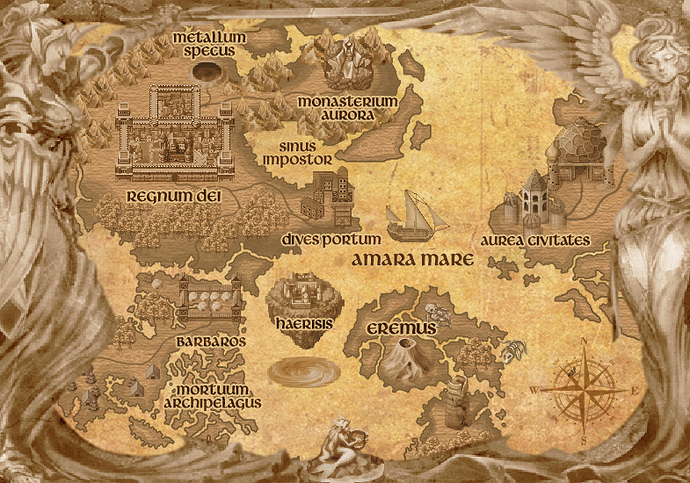oh yeah lemme just copy-paste the world map again since it’s a new thread
shit took like 30 hours and is the exact blend of medieval-cartography and snes jrpg overworld screen i wanted, it’s still probably the thing i’m proudest of that i’m directly responsible for
and the big dorky introductory loredump i wrote like two years ago and am not gonna bother to reread or edit haha #wow #owned
On the left and right of the map: artist’s depictions of Bellatrix and Aurora, respectively.
REGNUM DEI. Regnum Dei, or the Holy Kingdom, is a theocratic empire that ruled most of the continent throughout the Fifth Era. Conquest and food collection from vassal states allowed the capital city to reach a previously unheard-of population density, and even after its near-collapse in the civil war at the end of the Fifth Era, it remains one of the cultural centers of the known world. There’s nothing it doesn’t have, assuming you know where to look.
Regnum Dei shares its rule between an unstable royal family and a probably-corrupt High Council. It is kind of a political mess. It also hosts a knighthood that, over the course of centuries, has split from the church (the Monastery of Aurora); its main focus now is regaining territory lost after the civil war.
HAERESIS. Haerisis used to be the eastern half of Regnum Dei. In the year 967 of the Fifth Era, for unknown reasons, the prophet Eleanora declared a man named Mortzopholus the rightful ruler of the entire continent. Eleanora was killed in an ensuing fight for succession in Regnum Dei that grew into a decade-long civil war. The war ended with one of the greatest feats in the history of magic, when a hundred powerful wind and earth mages worked together to tear the eastern half of the city out of the ground, creating the floating island of Haerisis and what is now Impostor’s Bay, and marking the collapse of the kingdom and the end of the Fifth Era. The year is now 148 in the Sixth Era.
Haerisis is ruled by the descendants of Mortzopholus as a militant isolationist theocracy. It rarely interacts with the outside world aside from trading for food with Barbaros and attempting to gain influence over the Monastery of Aurora. For these reasons, among others, academics who want exposure to new ideas need to study abroad. Those that leave the island need to be careful when mentioning where they came from.
Each city refers to itself as the holy kingdom (Regnum Dei) and the other as heresy (Haeresis), and they refuse to agree on any politically neutral terms, which can make things very confusing.
MONASTERIUM AURORA. The monastery is massive and ancient, and is the closest thing followers of Aurora have to a centralized church. Both Regnum Dei and Haerisis claim dominion over it. Regnum Dei in particular has historically derived its legitimacy from the monastery, and has increasingly tried to bring it under state control. The monastery is split between traditionalists and supporters of the prophet Eleanora.
BARBAROS. Once a collection of territories belonging to Regnum Dei, after the end of the Fifth Era the region has been claimed by both Regnum Dei and Haerisis but is now largely independent. The region is humid, swampy, and populated mainly by small farming and fishing villages in the east, and nomadic, indigenous tribes farther south and west.
MORTUUM ARCHIPELAGUS. This large volcanic archipelago is sparsely populated and widely regarded as cursed, for long-forgotten reasons.
EREMUS. Even in Haeresis, where the prophet Eleanora is considered a saint, the spirit of her teachings tends to be ignored whenever it’s inconvenient. During the civil war, she said that it was wrong to spill another man’s blood, and all that happened was that her supporters switched from swords to warhammers and maces.
Something similar happened with the treatment of mutants (sometimes called the Changed, or even Bellatrix’s Children). They are physically deformed and infertile and often kill mothers in childbirth, and are thought of as devilspawn. When Eleanora said that mutant infanticide was wrong, her followers switched from killing them at birth to shipping them off to the inhospitable and previously uninhabited islands of Eremus, where they were left to die.
Over the course of a century and a half, Bellatrix’s Children managed to gain a foothold in Eremus and survive in small colonies through subsistence farming and creative usage of their unique, unnatural abilities.
A mutant tends to have one or two exceptional abilities which are offset by other severe weaknesses. They are still seen as subhuman by most followers of Aurora, and those that manage to leave Eremus (usually on their own, in secret) are widely ostracized and persecuted on the mainland, and are forced to live in hiding.
METALLUM SPECUS. For centuries, Regnum Dei has traded precious metals from these mines for silk and spices from the Golden Cities in the east. Their trade route has seen less use in the hundred and forty-odd years since the Sixth Era began but is still one of Regnum Dei’s major sources of income.
AMARA MARE. The Bitter Sea, mainly known as a leg in the trade route between Regnum Dei and the Golden Cities. It has a name that sounds much nicer than its meaning.
DIVES PORTUM. New Port, or sometimes New Haven, was built centuries ago around trade across the Bitter Sea and has become one of the most culturally diverse cities in the known world.
AUREA CIVITATES. Westerners know very little about the land beyond the Golden Cities, which is largely desert and populated mainly by small nomadic tribes. The Golden Cities grew out of centuries of trade and western influence. It is the home of traders, sailors and transients. Its wealth distribution is grotesque.









































